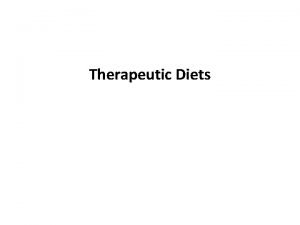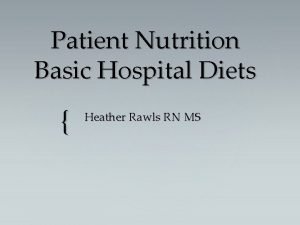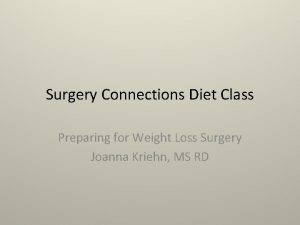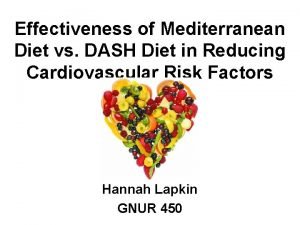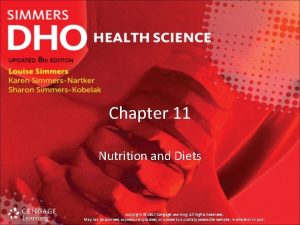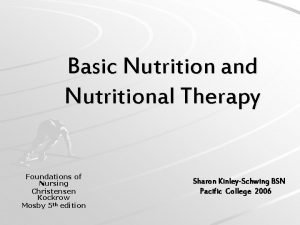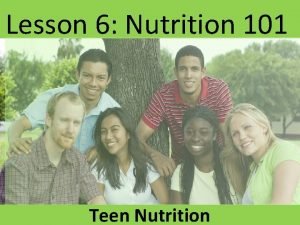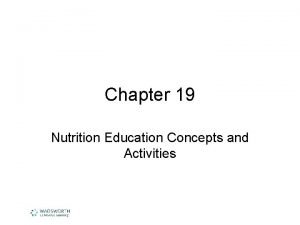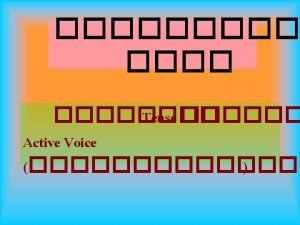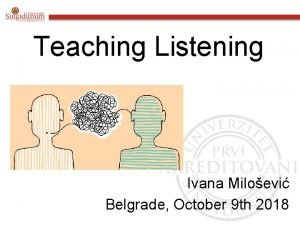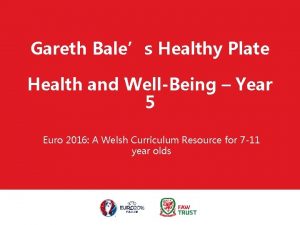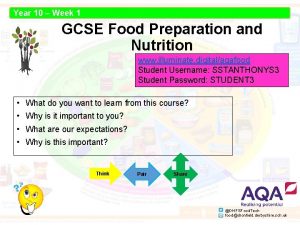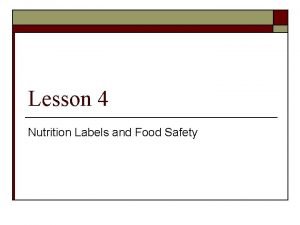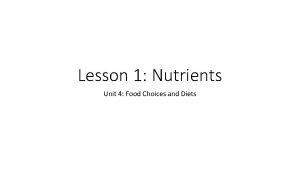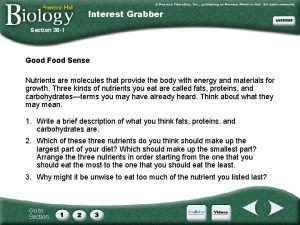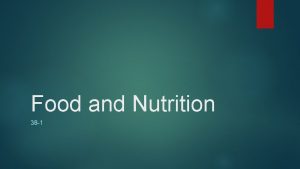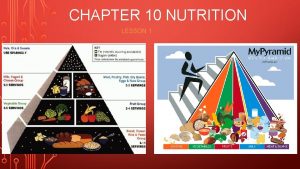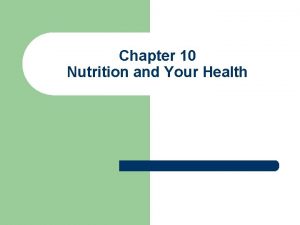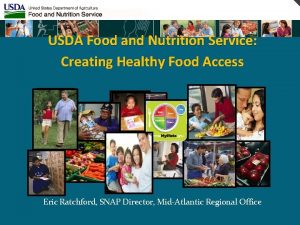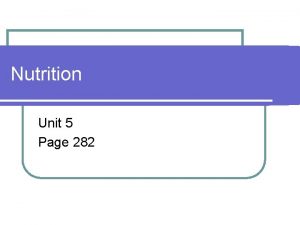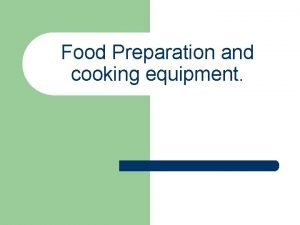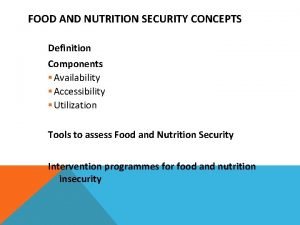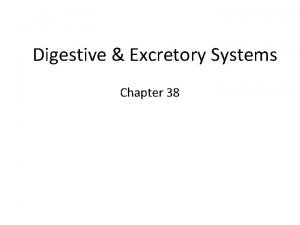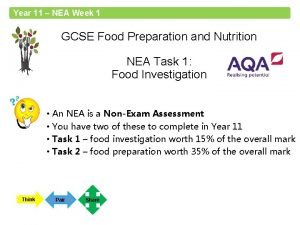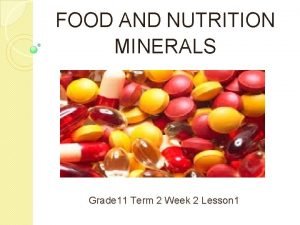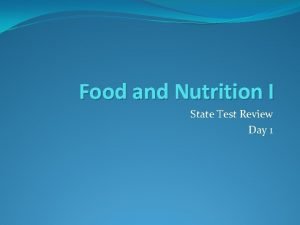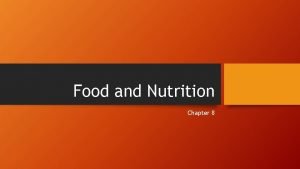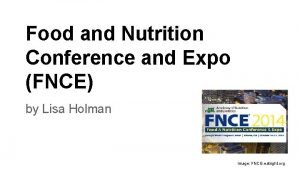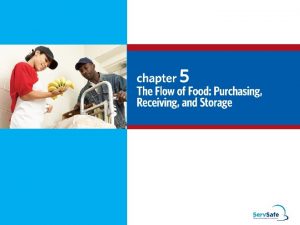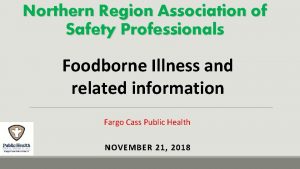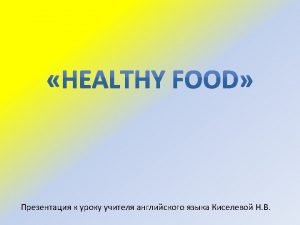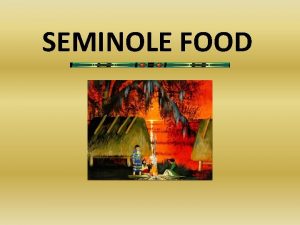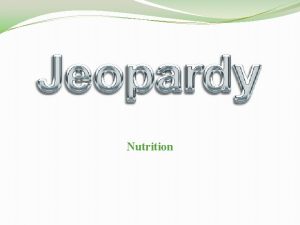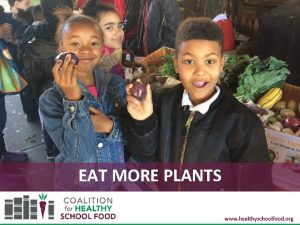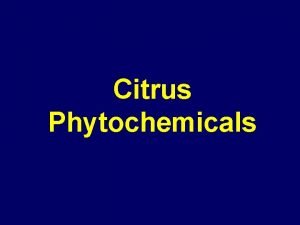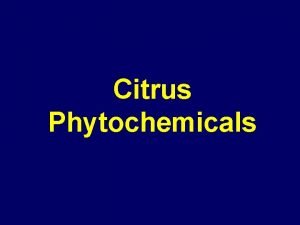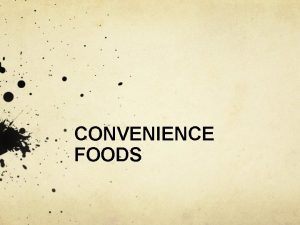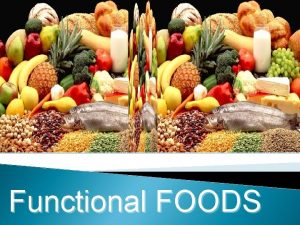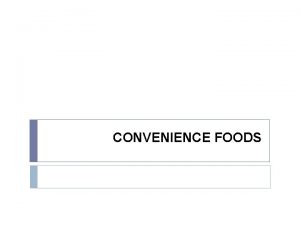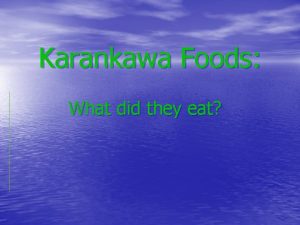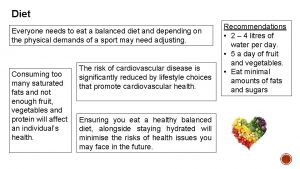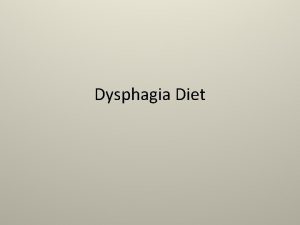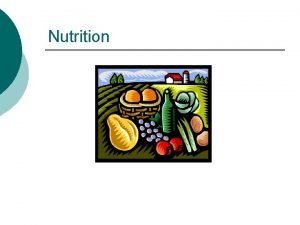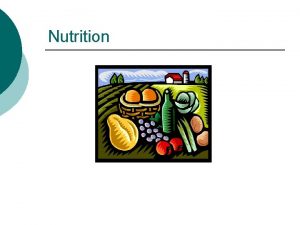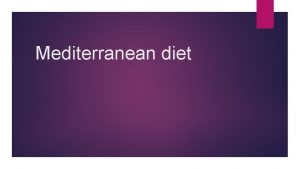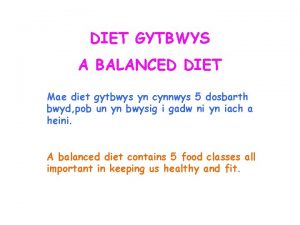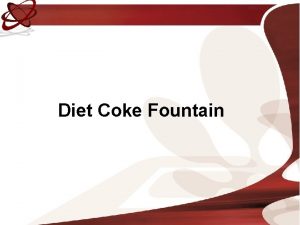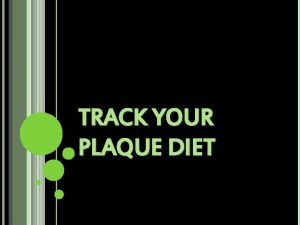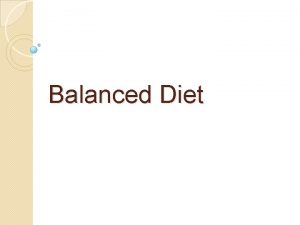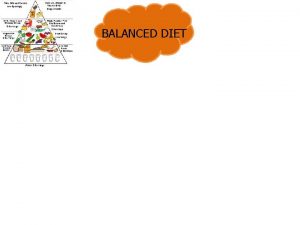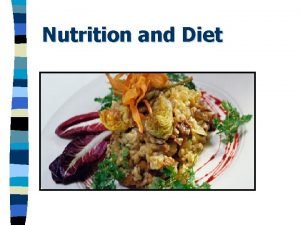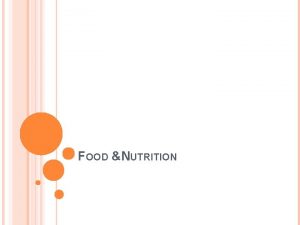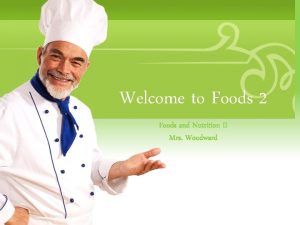Food and Nutrition Diet Foods we eat and






































- Slides: 38

Food and Nutrition

Diet • Foods we eat and drink daily.

Balanced Diet • Contains the correct proportions of foods to suit an individual’s needs. • Includes foods with the following nutrients: – Carbohydrates – Proteins – Fats – Vitamins – Mineral salts – Water – Fibre • Proportions vary from person to person.

Food Groups • There are 6 main food groups: – Fats and Oils – Legumes, peas and beans – Staples or cereals – Food from animals – Vegetables (green leafy and yellow) – Fruits

Carbohydrates • Made of Carbon (C), Hydrogen (H), and Oxygen (O) • Basic forms are saccharides or sugars – One sugar is a monosaccharide or reducing sugar • E. g. Glucose, fructose – Two simple sugars form disaccharides • E. g. sucrose, maltose – Sweet – Soluble − Provide energy

Carbohydrates • Complex forms are polysaccharides – Formed from many simple sugars • Starch • Cellulose (only in plants) – Insoluble – Stores glucose in the body

Lipids • Contain Carbon, Hydrogen and Oxygen • Made of fatty acids and glycerol • • • – Saturated (animals) – Unsaturated (plants) Insoluble in water Supply energy Carry fat soluble vitamins (A, D, E, K) Forms cell membrane and structures in brain Source of antioxidants

Proteins • Contain carbon, hydrogen, oxygen, nitrogen, sulphur and phosphorous • Made of amino acids or peptides – building block of proteins • Two amino acids form a dipeptide • More than two amino acids form a polypeptide • A large polypeptide forms a protein

Proteins • Used in the body for: – growth and repair – making: • Enzymes • Nails • Haemoglobin in blood

Vitamins • A – Vision in dim light – Carrots, spinach, egg yolk, butter • B complex – Helps in respiration – Rice, liver, leafy vegetables, fish • C – Keeps tissues healthy – Fruits, vegetables • D – Aids calcium absorption – Egg yolk, dairy products • E – Tissues healthy – Eggs, green vegetables • K – Blood clotting and making proteins – Green vegetables, bran, cereal, fruits, food from animals

• Iron Minerals – Liver, kidney – Make red blood cells, release energy • Calcium – Builds bones and teeth – Muscle contraction – Blood clotting

• Iodine Minerals – Part of thyroxine – Prevents goitres or swelling of the neck • Phosphorous – Builds bones and teeth – Needed in respiration

Minerals • Sodium Chloride (salt) – Part of blood plasma – Digestion – Passing nervous impulses • Potassium – Healthy skin – Normal growth – Passing nervous impulses

Fibre • Plant material that cannot be digested (Cellulose) – Breadfruit – Yams – Peas and Beans – Nuts – Whole wheat flour – Oats – Unrefined Cornmeal

Fibre • Keeps the intestines healthy • Relieves constipation – bowels do not move regularly or are not completely emptied. – causes diseases as toxins enter bloodstream and are transported around the body. • Guards against some cancers of the intestinal tract. • Helps in weight loss

Water • Solvent – dissolve minerals, nutrients and vitamins so they can be absorbed by body • Transport medium – Moves dissolved substances around the body and into cells • Hydrolysis – Used to break down complex molecules into simpler substances • Starch into monosaccharides

Malnutrition • Condition caused by an improper or insufficient diet over a period of time. – under nutrition due to inadequate consumption, poor absorption, or excessive loss of nutrients – over nutrition due to overeating or excessive intake of specific nutrients. • Results in starvation, disease, and infection.

Diseases • Deficiency Disease – Unbalanced diet or nutrient shortage • Rickets • Lack of Viatmin D • Kwashiorkor • Lack of Proteins • Scurvy • Lack of Vitamin C • Night Blindness • Lack of Vitamin A

What are Teeth? • Structures found in jaws of many vertebrates. – Mechanically break up food to increase the surface area for enzymes to work on. – Tear, scrape, chew and grind food. • Canines are highly developed in carnivores for tearing and ripping flesh.

Structure of a Tooth Crown Root cement

Parts of the Tooth • Crown - exposed part of tooth • Root - part embedded in jaw • Enamel – Hard substance covering outer surface • Dentine – main section of the tooth – living tissue like bone – not as hard or resistant to decay as enamel

Parts of the Tooth • Pulp cavity – nerve endings – blood vessels carry oxygen and nutrients in to cells, and remove waste • Cement – rough covering which holds tooth in place

Types of Teeth Type of Tooth Shape Function Incisor – Chisel shaped, with 1 root Cutting food into smaller pieces Biting off bits of food Canine –Pointed or dagger shaped, with 1 root Grasping and tearing food (well developed in carnivores for tearing flesh) Premolar – Flat, 2 cusps or bumps on the surface, 1 or 2 roots Crushing food (Mastication) Molar – Flat, 4 or 5 cusps on the surface. 2 – 4 roots Crushing and grinding food (Mastication)

What causes teeth like these. . .

. . . to turn into these teeth?

• Bacteria which cause the build up of plaque

How do Bacteria cause tooth decay? • Sugar from food remains on teeth and is eaten by Bacteria which forms an acid. Bacteria

• Bacteria then forms a sticky coating on your teeth called Plaque. • The Plaque contains the Acid which rots away the enamel of your tooth, exposing the Dentine. • This is the result - TOOTHACHE!!

How can we prevent bacteria from attacking our teeth? • Regular brushing – After eating – Before going to bed. • • Regular dentist visits. Drink lots of milk and eat cheese and fruit. Cut down on sweets and cakes. Drink water with FLUORIDE.

Digestion • The process of breaking down large, complex, insoluble material into small, simple, soluble molecules. – Teeth: Mechanically break down food into smaller pieces to increase the surface area for enzymes to work on. – Enzymes: Chemically break down food molecules into smaller pieces. • Organic catalysts which speed up reactions

The Digestive System colon rectum anus

Digestion

Parts of Digestive System • Mouth: 1 st site of digestion – Mechanical: by teeth – Chemical: by enzymes (salivary amylase) found in saliva • Oesophagus – Muscular tube connecting mouth to stomach – Peristalsis moves food down • Stomach – Chemical digestion – Muscular organ mixes food with gastric juices (enzymes, mucus and hydrochloric acid) to form chyme.

• Small Intestine: – Duodenum: 1 st region (digestion completed) • Receives chyme, bile and pancreatic juice – Bile: made in liver, stored in the gall bladder to break down fat into smaller droplets (emulsification) – Pancreatic juice: made in pancreas, contains enzymes (amylase, lipase, trypsin), sodium hydrogencarbonate – Ileum: site of absorption • • • Absorption: Diffusion of soluble food molecules into blood 6 m long with large surface area formed by folds called villi Cells with many mitochondria for energy to transport nutrients Good blood supply Lacteal or lymph capillary to absorb fatty acids Assimilation: process of using and incorporating digested food into the body

Structure of the small intestine

• Large Intestine /Colon – Transports undigested food, dead cells and bacteria (faeces) – Reabsorbs water from faeces • Rectum – Temporarily stores faeces – Faeces enter anus where it is egested from the body • Egestion or defaecation: process of removing undigested food from the body

Enzymes in Digestion Enzyme Examples Produced by Location p. H Substrate Products Carbohydrase Amylase Salivary glands Mouth 6 -7 Starch Maltose Protease Pepsin Stomach wall Stomach 2 -3 Proteins Peptides Carbohydrase Amylase Pancreas Small Intestine 7 -8 Starch Maltose Maltase Small Intestine Maltose Glucose Trypsin Pancreas Protein Peptides Peptidase Small intestine Peptides Amino acids Lipase Pancreas Lipids Fatty acids , glycerol Protease Lipase Small intestine Small Intestine 7 -8

Food Additives • Added to food to: – Preserve food – Make food attractive – Make food taste better • HW Exercise 3 1 -5
 What is a liquid diet
What is a liquid diet Abcd of nutritional assessment
Abcd of nutritional assessment Liquid diet
Liquid diet Dash vs mediterranean diet
Dash vs mediterranean diet Test chapter 11 nutrition and diets
Test chapter 11 nutrition and diets Chapter 11 nutrition and diet
Chapter 11 nutrition and diet Fundamentals of nursing nutrition
Fundamentals of nursing nutrition Best diet for basketball players
Best diet for basketball players Foods used in nutrition activities should be nutrient-dense
Foods used in nutrition activities should be nutrient-dense I would rather eat potatoes than eat rice.
I would rather eat potatoes than eat rice. I eat, you eat, he eats
I eat, you eat, he eats People buy me to eat but never eat me what am i
People buy me to eat but never eat me what am i Unit 2 food food food
Unit 2 food food food Food chain food chain food chain
Food chain food chain food chain Wellbeing plate
Wellbeing plate Gcse food tech high skill dishes
Gcse food tech high skill dishes Datingoo
Datingoo Food and nutrition unit 4
Food and nutrition unit 4 38-2 the process of digestion
38-2 the process of digestion Rda food label
Rda food label Section 38-1 food and nutrition
Section 38-1 food and nutrition Chapter 10 nutrition for health lesson 1 answer key
Chapter 10 nutrition for health lesson 1 answer key Chapter 10 lesson 4 nutrition labels and food safety
Chapter 10 lesson 4 nutrition labels and food safety Usda food and nutrition service
Usda food and nutrition service Food and nutrition unit 5
Food and nutrition unit 5 Factors to consider when choosing labour saving devices
Factors to consider when choosing labour saving devices Nutrition security meaning
Nutrition security meaning Questions on digestive system
Questions on digestive system Nea food tech example
Nea food tech example Food and nutrition grade 11
Food and nutrition grade 11 Endosperm of wheat
Endosperm of wheat Chapter 8 food and nutrition
Chapter 8 food and nutrition Food and nutrition expo
Food and nutrition expo Ready to eat tcs food
Ready to eat tcs food Big 6 illnesses
Big 6 illnesses What crops did the iroquois grow
What crops did the iroquois grow What is your favorite food interview question and answer
What is your favorite food interview question and answer How will eat food
How will eat food What did seminoles eat
What did seminoles eat
